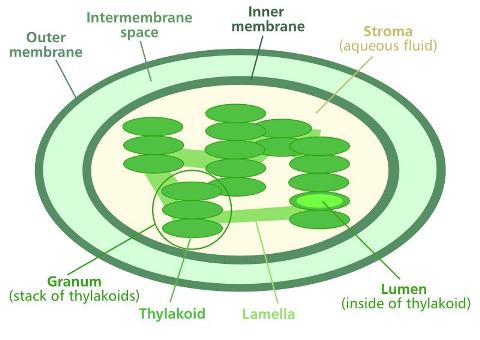Is Chloroplast Found In Animal Or Plant Cells
Science >> Biology for Kids
Biology
Plant Prison cell Chloroplasts
What are chloroplasts?Chloroplasts are unique structures constitute in plant cells that specialize in converting sunlight into energy that plants can use. This procedure is chosen photosynthesis.
Organelle
Chloroplasts are considered organelles in plant cells. Organelles are special structures in cells that perform specific functions. The master function of the chloroplast is photosynthesis.
Chloroplast Structure
Well-nigh chloroplasts are oval-shaped blobs, but they tin can come in all sorts of shapes such equally stars, cups, and ribbons. Some chloroplasts are relatively small compared to the cell, while others may accept up the majority of the space inside the jail cell.
- Outer membrane - The outside of the chloroplast is protected by a smooth outer membrane.
- Inner membrane - Just inside the outer membrane is the inner membrane which controls which molecules can pass in and out of the chloroplast. The outer membrane, the inner membrane, and the fluid betwixt them brand upwardly the chloroplast envelope.
- Stroma - The stroma is the liquid inside the chloroplast where other structures such as the thylakoids float.
- Thylakoids - Floating in the stroma is a collection of sacks containing chlorophyll called the thylakoids. The thylakoids are oft arranged into stacks called granum as shown in the moving picture below. The granum are connected past disc-like structures called lamella.
- Pigments - Pigments give the chloroplast and the establish its color. The most mutual pigment is chlorophyll which gives plants their green colour. Chlorophyll helps to absorb free energy from sunlight.
- Other - Chloroplasts have their ain Dna and ribosomes for making proteins from RNA.

Photosynthesis
Chloroplasts use photosynthesis to plough sunlight into food. The chlorophyll captures free energy from calorie-free and stores it in a special molecule called ATP (which stands for adenosine triphosphate). After, the ATP is combined with carbon dioxide and water to brand sugars such equally glucose that the plant can use equally food.
Other Functions
Other functions of chloroplasts include fighting off diseases equally part of the jail cell's immune system, storing energy for the cell, and making amino acids for the cell.
Interesting Facts nigh Chloroplasts
- Simple cells, like those institute in algae, may only accept one or two chloroplasts. More complex institute cells, all the same, may contain hundreds.
- Chloroplasts will sometimes movement effectually within the prison cell in society to position themselves to where they can best absorb sunlight.
- The "chloro" in chloroplast comes from the Greek give-and-take chloros (pregnant green).
- The nearly abundant poly peptide in chloroplasts is the poly peptide Rubisco. Rubisco is likely the most arable poly peptide in the globe.
- Man and animal cells do non need chloroplasts because we get our energy from eating and digesting nutrient rather than through photosynthesis.
- Scientists guess that there are around 500,000 chloroplasts in a single foursquare millimeter of a leaf.
- In that location are actually different colors of chlorophyll. Chlorophyll A is the most common type and is green. Chlorophyll C is a golden or brown color.
- Accept a ten question quiz well-nigh this page.
- Listen to a recorded reading of this folio:
More Biological science Subjects
Science >> Biology for Kids
Source: https://www.ducksters.com/science/biology/cell_chloroplasts.php
Posted by: clarksonoblipt58.blogspot.com

0 Response to "Is Chloroplast Found In Animal Or Plant Cells"
Post a Comment